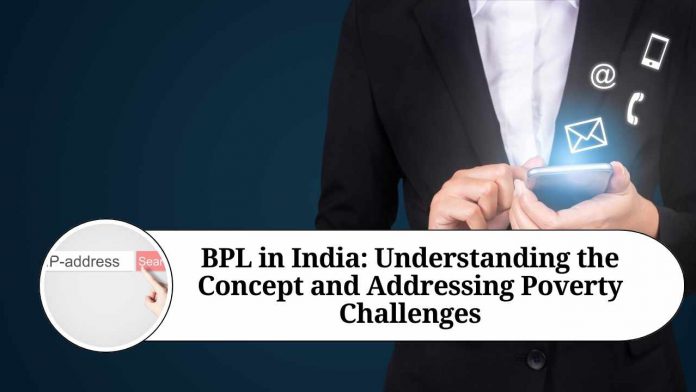BPL (Below Poverty Line)
According to the Indian government, households with an income of less than INR 10,000 per annum in rural areas and INR 12,000 per annum in urban areas are considered below the poverty line. However, this definition has been subject to criticism, as it does not take into account factors such as inflation and the cost of living in different parts of the country.
The BPL concept was first introduced in India in the early 1960s, to provide targeted assistance to those who were most in need. Since then, various government programs have been launched to support BPL households, including food subsidies, housing schemes, and employment generation programs.
However, despite these efforts, poverty remains a major challenge in India, with a large proportion of the population still living below the poverty line. According to a 2020 report by the World Bank, around 270 million people in India were living below the poverty line in 2016.
One of the main reasons for this is the high level of income inequality in the country. While India has made significant progress in reducing poverty over the past few decades, the benefits of economic growth have not been evenly distributed, with the richest 10% of the population accounting for over half of the country’s wealth.
Another factor that contributes to poverty in India is the lack of access to basic services such as healthcare and education. Many BPL households are unable to afford the cost of medical treatment or send their children to school, which further perpetuates the cycle of poverty.
To address these challenges, the Indian government has launched various initiatives aimed at promoting inclusive growth and reducing poverty. These include the National Rural Employment Guarantee Act (NREGA), which provides guaranteed employment to rural households, and the Pradhan Mantri Jan Dhan Yojana, which aims to provide financial inclusion to all households.
Poverty is not just an economic issue, it is also a social and political issue. It affects every aspect of a person’s life, from their health and education to their social status and opportunities for advancement.
One of the biggest challenges in addressing poverty in India is the lack of accurate data on the number and location of BPL households. This makes it difficult to target resources and support those who need it the most. To address this, the Indian government has launched various initiatives to improve data collection and analysis, including the Socio-Economic and Caste Census (SECC).
Another important aspect of tackling poverty in India is addressing gender inequality. Women and girls are disproportionately affected by poverty, with lower levels of education and higher rates of malnutrition and maternal mortality. To address this, the government has launched various initiatives aimed at promoting gender equality, including the Beti Bachao, Beti Padhao (Save the Girl Child, Educate the Girl Child) campaign.
Despite these efforts, poverty remains a complex and multifaceted issue in India. It requires a holistic approach that addresses the root causes of poverty and promotes inclusive growth and development. This includes improving access to basic services such as healthcare and education, promoting sustainable and inclusive economic growth, and tackling social and political inequalities.
At the same time, poverty reduction efforts must also be tailored to the specific needs and challenges of different communities and regions within India. This requires a nuanced understanding of the diverse socio-economic and cultural contexts in which poverty is experienced.
conclusion
the BPL concept is an important tool for identifying and supporting households that are most in need. However, it is just one aspect of a broader effort to address poverty and promote inclusive development in India. By taking a holistic and context-specific approach to poverty reduction, India can ensure that all its citizens have access to the necessities of life and the opportunity to thrive and prosper.
Other Related Blogs: Section 144B Income Tax Act
Frequently Asked Questions
Q: What is BPL (Below Poverty Line)?
A: BPL is a term used to describe individuals or families who are living below a certain level of income or expenditure, indicating that they are unable to meet their basic needs.
Q: What are the criteria to be considered BPL in India?
A: In India, households with an income of less than INR 10,000 per annum in rural areas and INR 12,000 per annum in urban areas are considered below the poverty line.
Q: What are the challenges in addressing poverty in India?
A: Some of the challenges in addressing poverty in India include income inequality, lack of access to basic services such as healthcare and education, gender inequality, and lack of accurate data on the number and location of BPL households.
Q: What initiatives has the Indian government launched to address poverty?
A: The Indian government has launched various initiatives to address poverty, including the National Rural Employment Guarantee Act (NREGA), the Pradhan Mantri Jan Dhan Yojana, the Socio-Economic and Caste Census (SECC), and the Beti Bachao, Beti Padhao campaign.
Q: How can poverty reduction efforts be tailored to specific communities and regions in India?
A: Poverty reduction efforts can be tailored to specific communities and regions in India by taking into account the diverse socio-economic and cultural contexts in which poverty is experienced and designing targeted interventions to address the specific needs and challenges of different communities and regions. This requires a nuanced understanding of the local context and close collaboration with local communities and stakeholders.




















